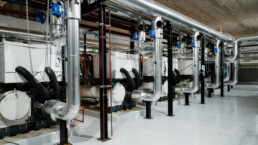As part of an ambitious effort to host the first carbon-neutral Olympic games, Paris has expanded its emissions-reducing cooling system.
By Miranda Linton, Reasons to be Cheerful
Paris has been preparing for the 2024 Summer Olympics for a decade. In the final days leading up to the big event, organizers readied for the Seine to host a dramatic opening ceremony, during which athletes will float down the river on boats, with the Eiffel Tower laying backdrop to it. One ambitious goal among these preparations: to host the first carbon-neutral Olympics in modern history.

The city’s strategy is vast, from using 95 percent existing or temporary infrastructure (only building facilities that can be used after the Games) to sourcing 80 percent of food locally. And in a climate-friendly effort to keep athletes and attendees cool and comfortable throughout the event, the Olympics are foregoing traditional air conditioning in exchange for an alternative cooling system — one which will use river water from the Seine to cool all buildings affiliated with the event.
The system driving this operation is called district cooling, and its technology long predates this summer’s Olympics. The first system of its kind was built in 1962 in Hartford, Connecticut, and has since grown to be one of the largest in the world. The city’s gas company at the time had connected to all the interstate pipelines, bringing a surplus of gas to the city, which went unused in the summer. So a district energy system was created through which gas could be used to chill water and cool buildings in the summer, and steam for heat in the winter.
Created in 1991, Paris’ district cooling network is already Europe’s largest, currently serving more than 2,000 buildings in the south of the city, and its recent growth to meet the Olympics’ climate goals has cemented its lead in the rankings.
ENGIE, the company behind the cooling system, is using water from the Seine and recovered heat from a data center to heat the Olympic pool. ENGIE has also created a cooling system — separate from the central system in Paris — for the Olympic Village, which will turn into housing after the Olympics conclude. With sustainability in mind, the Village was constructed in a way that generates 50 percent fewer greenhouse gas emissions than standard construction, using wood rather than steel in small buildings and low-carbon concrete in larger ones. The housing will also include affordable units.
So how does this emissions-reducing air cooling apparatus function?
“District cooling is a central plant or plants that produce chilled water,” explains Rob Thornton, president and CEO of the nonprofit International District Energy Association. “There is a network of insulated pipes in which water is pumped (generally underground), and then the connected buildings receive cold water, which flows into a heat exchanger. The cold water absorbs the heat from the space, and the warmer water flows back into the central plant. It’s a closed loop.”
District cooling systems maintain a few advantages over traditional air conditioning, which functions by sucking air out of an area to cool the gas in the air conditioning system, after which the cooler air is blown back into the space.
District cooling reduces the space requirements for individual air conditioning units, which usually reside on rooftops and perpetuate the urban heat island effect, in which cement causes cities to become hotter than their rural surroundings. In Paris, where roofscapes are high-value properties, utilizing an alternative system frees up all this space for other uses, which could take the form of rooftop gardens or other heat-absorbing environments.
According to Thornton, the cost of cooling cities can be decreased by 50 to 90 percent through the use of district cooling. That is, after the initial investment in the infrastructure, which can cost up to $1 billion. The source of this investment varies from country to country. In the US, Thornton says, it is primarily private investment, though the federal government can support some initial costs through the Inflation Reduction Act.
“In other locations like Dubai, it’s often sovereign wealth funds, so a combination of public and private capital,” says Thornton. “In Dubai, they’ve cut both carbon emissions and electricity demand in half. So they see a dividend both economically and environmentally.”
These systems are most suitable to urban centers, as they require a certain level of population density to be economically feasible — which is good news considering the population centers around the world exist predominantly in hotter climates. Asian cities make up about half of the most populated capitals globally, and these are the same cities that have seen some of the most dramatic recent temperature increases.
And cities that historically haven’t required air conditioning, like those in the Pacific Northwest of the US, are now turning to district cooling as they face increasingly hotter temperatures.
District cooling can also help cities save water. The system feeds off of undrinkable river water, rather than water of a quality that could be consumed by its inhabitants. And because it’s a closed-loop system, the water that comes out of the river is injected right back into the river once it’s cooled the air. The water that goes back is a slightly higher temperature than it was when it came out, which is why Olivier Racle, head of district heating and cooling at ENGIE, says there must be strict regulations to mandate a temperature ceiling for the water — typically around five degrees above the original temperature.
“This is highly regulated in order to limit as much as possible the impact on the biodiversity of the river,” says Racle.
District cooling systems can be utilized year-round, even in the colder months. “Cities are like a human body, they need cooling year round,” says Thornton. “Even if it’s cold outside, the inside of the buildings may need cooling.”
But the impact will be most dramatic in the summer months, when air conditioning puts the biggest load on the electricity grid. With district cooling, peak demand can be relieved during hot days because chilled water can be produced overnight, during off-peak hours, and stored for use during the day.
As the Olympics fire up, district cooling will play a critical role in keeping participants and spectators cool, putting its impacts in the spotlight as such systems are used in increasing numbers of cities around the world.
Recent Posts
Billionaire’s Mouthpiece Searches For Reasons To Avoid Taxing Billionaires
January 9, 2026
Take Action Now California is considering a referendum on whether to impose a one-time wealth tax on the state’s billionaires.By Jim Naureckas,…
All Democratic Presidential Candidates In 2028 Should Commit To Dismantling ICE
January 8, 2026
Take Action Now Since its inception, ICE has been designed to conflate issues of immigration with terrorist threats against the U.S.By Sam…
Trump Cuts Billions In Federal Childcare Funds For Democratic-Led States After Minnesota Fraud Scandal
January 8, 2026
Take Action Now Administration cites welfare fraud allegations as advocates and state leaders warn of political retaliation and sweeping harm to…
After The ICE Killing In Minneapolis, Will Truth Prevail?
January 8, 2026
Take Action Now Can Trump and Kristi Noem maintain their blatant lies in the face of multiple videos that show the victim was trying to drive away…




